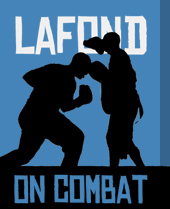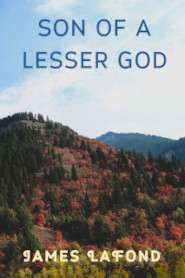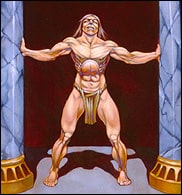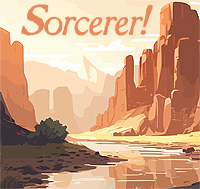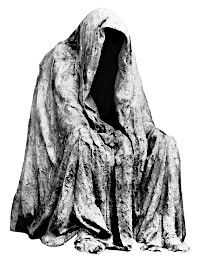If ever there was a stock Conan tale by Howard that would make a decent modern action movie without much rewriting and would entertain audiences in our age, Red Nails is it. There are the standard lost African city elements that Howard and Burroughs reveled in, with the horny brute Conan—who got into this adventure because he deserted an army to follow a female soldier with a great figure, who had escaped after killing an officer who tried to rape her—serving as ethnographer and architecture critic:
“The pay was poor and the wine was sour, and I don’t like black women. And that’s the only kind that came to our camp at Sukhmet—rings in their noses and their teeth filed—bah!”
[Note that Howard’s other heroes favor black women and mixed race beauties.]
“I’ve been this far south but not this far east. Many days travelling to the west will bring us to the savannas, where the black tribes graze their cattle. I have friends among them.”
“Could black people build a city like that?”
Where Red Nails shines is in the development of Conan’s relationship with the female lead, Valeria, who was the basis for the movie babe in the first Conan film, and who, alone among Howard’s female characters, was equal to a man in combat prowess and physicality, though, to the superman, Conan, she was just a baby doll.
But there is something more. In Red Nails Howard goes to more trouble than in most stories to sketch the barbarian [read alienated] psychology of his rude hero.
“This exhibition of primordial fury chilled the blood in Valeria’s veins, but Conan was too close to the primitive himself to feel anything but a comprehending interest. To the barbarian, no such gulf existed between himself and other men, and the animals, as existed in the conception of Valeria. The monster below them, to Conan, was merely a form of life differing from himself mainly in physical shape…feeling a kinship with all things, even dragons, it was impossible for him to experience the sick horror which assailed Valeria at the sight of the brute’s ferocity.”
Finally, in this last Conan story, written right before his death, Robert E. Howard, spelled out what he had alluded to in Beyond the Black River and The Black Stranger, that while his fictional barbarian wore the outward trappings of a Celtic warrior from the days of Rome, that he was, inwardly, an American Indian, the kind of barbarian that Howard had in his own family, in the form of a contentious uncle.
The focus on human behavior, and how rotten civilization can get, then takes over the book in the form of “The people of the feud” the two clans of rival Asians devoted to murdering each other inside their enclosed city, even as an insane wizard prowls the catacombs and an evil witch drinks the blood of young women to keep herself young—and sets her eyes on Valeria with chilling intensity.
This is probably the first Conan story a new reader should tackle, so the plot will not be exposed here. Suffice it to say, that this is Howard’s statement on what happens to a soft decadent civilization—a descent into savagery and violence. Conan speaks with comic offense, when seeing paintings of the people who built the city doing nothing but drinking, feasting and making love, “Easterners, all right, “ grunted Conan, “but from where I don’t know. They must have lived a disgustingly peaceful life, though, or they’d have scenes of wars and fights.”
Finally, amid unparalleled brutality, Howard makes a statement on free will, with one of his better supporting characters, a simple warrior who decides to go against the dictates of his sick society.
The audiobook is available at the link below.


